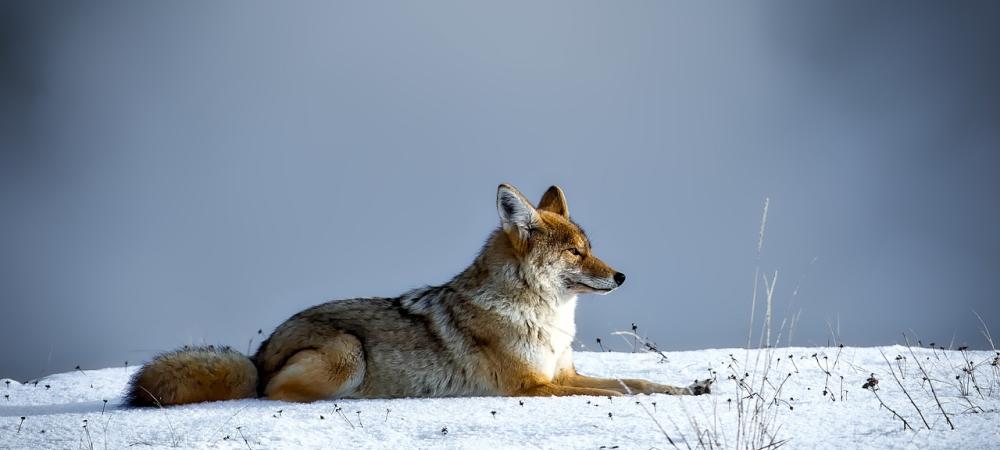How to Keep Coyotes Away: A Comprehensive Guide

Tired of being awoken in the middle of the night by the howls of a pack of coyotes? Or are you tired of finding your trash cans knocked over and your pets missing? Then, this ultimate guide on how to keep coyotes away is just for you!
Now, you may be thinking, "But wait, coyotes are so cute, especially baby coyotes. Can't I just make friends with them?" Well, I hate to break it to you, but no. Coyotes are wild animals and they prefer to keep their distance from humans. So, it's best to take the necessary steps to keep them away from your property.
Trust me, you'll thank yourself later when you're able to enjoy a peaceful night's sleep without the serenade of coyotes. So buckle up and let's get started on this wild ride!
Understanding Your Furry Foes
You've seen them in your backyard, howling at night, and you're wondering what on earth they are doing there.
But, what is a coyote?
Coyotes are medium-sized mammals that belong to the genus Canis and are closely related to wolves and dogs. They can be found throughout North America, including Mexico and Canada. But don't let their size fool you - these animals are surprisingly adaptable and flexible. In fact, they can survive in a wide range of habitats from arid deserts to urban areas!
Now that we know who they are, let's talk about black coyotes specifically. Contrary to popular belief, there is no such thing as a black coyote – all of them have primarily grayish fur with black patches scattered throughout their bodies. The only difference is the color of the fur – some may be darker than others due to environmental factors or genetics.
Let's move on to size: How big are coyotes exactly? Depending on its habitat or subspecies, it could weigh anywhere between 20-50 pounds (9-22 kilograms). This means that an adult male can grow up to 4 feet (1.2 meters) in body length!
Now that we know what they look like and how big they get, let's talk about food: What do coyotes eat? Well, contrary to popular belief again – roadrunners aren't the only things on their menu! Coyotes feed on small mammals such as rodents and rabbits; birds; eggs; fruits; vegetables; insects; carrion (dead animals); and fish when available near water sources. They will also scavenge for human food scraps if available!
But why exactly are these animals bothering you in the first place? Well, this one is quite simple – food! That's right – your garbage cans might be attracting all sorts of wildlife because it provides them with easy access to food which is essential for survival during lean times (e.g., colder months). To prevent this from happening in the future make sure you keep your trash secure - either by using lids or storing it inside a shed or garage until pick up day arrives!
Are Coyotes Dangerous? Well, Prevention Is Key
When it comes to coyotes, it pays – literally – to take preventive measures. Coyotes are resilient and adaptable, which means they can easily find new homes and habitats in urban areas. But just because a coyote has made its way into your backyard doesn’t mean you have to worry about these wild animals. The truth is, coyotes are generally shy of humans and rarely attack people or pets.
That said, if you do have a baby coyote on your property, it’s best to leave it alone and call wildlife removal since young coyotes can become quite bold and territorial when they feel threatened or provoked. After all, prevention is the key!
No one likes the idea of having a wild animal on their property – after all, even docile ones like deer can be dangerous if they spook or stampede! That’s why keeping coyotes away should be a top priority for anyone living near open fields or wooded areas where these animals naturally roam.
Fortunately, there are several steps you can take to make your yard less inviting to coyotes: Landscaping – creating an uninviting environment for coyotes by planting thick vegetation that makes entering your yard difficult; Fencing – building a fortress around your property with tall fences that block out the view of any potential intruders; Trash Talk – properly disposing of waste to avoid attracting hungry scavengers; and lastly Pets Safety – ensuring that your beloved pets remain safe by keeping them indoors at night so as not to tempt any late-night snack seekers.
So remember: prevention is key when it comes to how to keep coyotes away from wreaking havoc in your backyard! Adopting these practices now will save you time and money in the long run – not just from potential damages caused by these wild animals but also from costly fines imposed by local wildlife regulations.
Who Says You Can’t Keep Coyotes Away? Deterrents Actually Work
Sure, coyotes may be pesky little critters, but there are plenty of deterrents that actually work. From loud noises to motion-activated lights and even chemical repellents, you can make sure those coyotes stay away from your property.
Let’s start with the power of noise.
If you want to scare off a coyote with sound, you have to make sure it’s loud enough for them to hear. It could be anything from a traditional alarm system to an air horn or just banging on some pots and pans (just don’t forget the spatula!). The key is making sure it’s loud enough for the coyote to hear from far away and think twice about coming closer.
Next up are those motion-activated lights. Not only do they scare off any intruders, but they also give you an extra layer of security by lighting up your property when something triggers them. Plus, if you happen to spot a coyote in your yard at night, the light will certainly help!
There are chemical repellents as well. These are great because they work by releasing smells or other substances that make it difficult for coyotes to get close to your property without feeling like they’re being watched or targeted. Just remember: these products should always be used according to instructions and should never be applied directly onto plants or animals.
What to Do if a Coyote Approaches
If you’ve ever been walking through a park, hiking in the woods, or even relaxing in your own backyard, and spotted a coyote lurking nearby, you know how intimidating it can be. Don’t panic!
While all wild animals should be respected and given their space, coyotes are actually typically more scared of humans than we are of them. They tend to avoid us, so if you see one, just back away slowly until it runs off. To make sure you stay safe if you do encounter one of these smart creatures, here are some tips on what to do if a coyote approaches:
First and foremost - don't run! Although your first instinct might be to turn around and sprint away in terror, running could actually trigger a coyote's natural chase instinct. So instead, stand your ground, make yourself look as big as possible by waving your arms and shouting at the animal (in a loud but non-threatening voice) until it leaves. If that doesn't work, try throwing sticks or small stones in its direction without actually hitting it - this is usually enough to persuade a coyote that there's nothing worth sticking around for.
If you're out with pets or small children when you encounter a coyote, keep them close and move towards the nearest shelter or populated area as quickly as possible. Of course, there are other ways to protect your furry friends from coyotes too – such as keeping an eye on them when they're outside and installing motion-activated lights or noise-making devices around your yard to scare any intruders off.
Finally – whatever happens – don't play dead! Coyotes aren't interested in killing humans like other predators may be; they just want their food - so they're easily discouraged by any sign of life. So stay alert! Make lots of noise – shout loudly – wave those arms wildly – anything to show the coyote that you mean business and won't take any nonsense from him!
At the end of the day - though encounters with coyotes can be scary - they're usually just passing through on their way somewhere else and aren't looking for trouble. Just remember: stay calm (but not too calm!), keep an eye on your little ones/pets at all times, make yourself look big and loud whenever possible – then back away slowly until the animal makes its exit. Not only will this help ensure that everyone stays safe during an encounter with this wild creature; but hopefully after seeing how bravely you stood up for yourself against his furry nemesis – he'll think twice about picking another fight!
Q: Do coyotes attack humans?
A: Yes, coyotes can attack humans, especially if they feel threatened or are habituated to people, but such attacks are rare and can usually be prevented by taking simple precautions, such as not feeding them, securely storing trash, and supervising small children and pets. It is important to remember that coyotes are wild animals and should be respected as such.
Q: What does a coyote look like?
A: A coyote has a slender body with a narrow, pointed snout and large triangular ears. It is typically tan to gray in color with a bushy tail. An adult coyote is about 4 feet long from nose to tail and weighs around 30 to 50 pounds.
Q: What does a coyote sound like?
A: A coyote sounds like a high-pitched, yipping howl, sometimes described as a "yip-howl." It can also make barks, yelps, and whines.
Q: Are coyotes nocturnal?
A: Coyotes are primarily crepuscular, meaning they are most active during dawn and dusk, but they can also be active at night and during the day.
Q: Do coyotes hunt in packs?
Coyotes rarely hunt in packs. They are commonly known to hunt alone or in pairs. Hunting strategies depend on various factors, such as the prey size, habitat, and season. In areas where coyotes have to hunt larger prey or in winter, they may hunt in packs to increase their chances of success. However, in areas with abundant smaller prey or during summer, they hunt alone or in smaller groups. Overall, they are adaptable and opportunistic predators and can adjust their hunting behavior to the environment they live in.
Q: How high can a coyote jump?
A: A coyote can jump up to 3-4 feet high.

